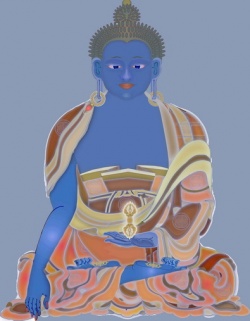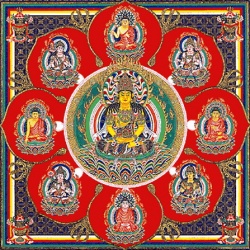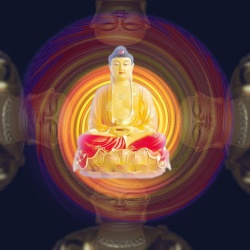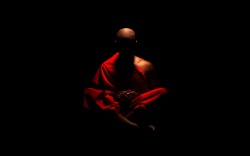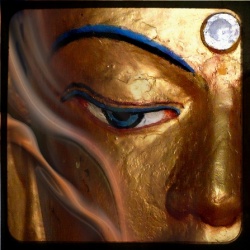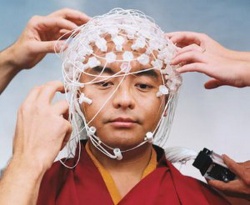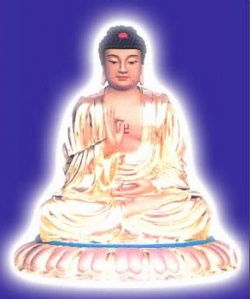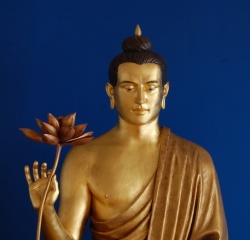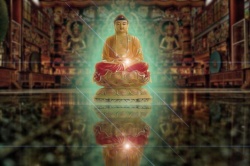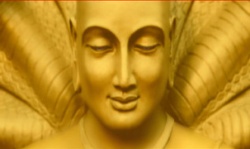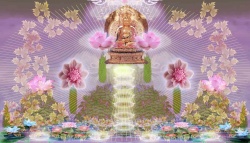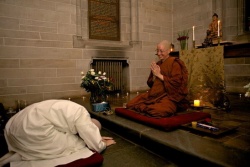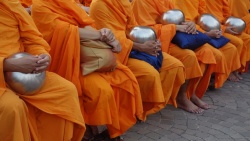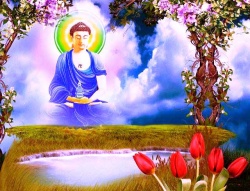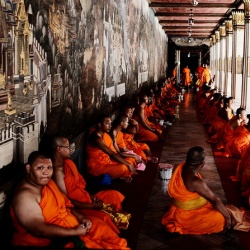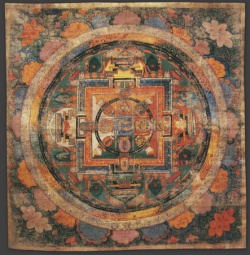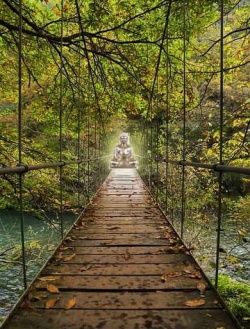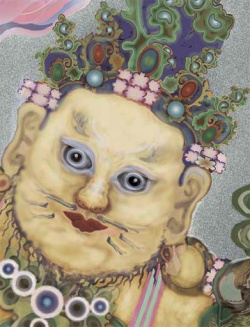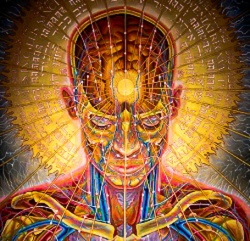Why Buddha was Discontent with the Eighth Jhana
One of his students asked Buddha, “Are you the messiah?”
“No”, answered Buddha. “Then are you a healer?”
“No”, Buddha replied. “Then are you a teacher?” the student persisted.
“No, I am not a teacher.”“Then what are you?” asked the student, exasperated.
“I am awake”, Buddha replied.”
The original Buddhism, called Theravada or Hinayana, has two main approaches to meditation: the practice of the eight jhanas and vipassana (insight). Most Buddhist teachers tend only to teach vipassana.
There may be several possible reasons for this. One is that there appears to be a certain conflict between these two approaches, within which vipassana has been favored.
Another is that the knowledge of how to teach the eight jhanas has been lost; the instructions given are indeed quite vague and open to interpretation.
It could also be because Buddha himself often presented a simplified system of teaching, which was a combination of the practices of mindfulness and vipassana. Added to this there is the somewhat mythologized rendering of Buddha’s life, which tells us that he himself did not reach enlightenment through the practice of the jhanas but rather through contemplating the causes of suffering and impermanence.
This has subsequently become the main theme of vipassana meditation and the central practice of Theravada Buddhism. However, what is often forgotten is the Buddha himself used the jhanas in order to enter meditation, including during his final meditation under the Bodhi tree.
‘Jhana’ is a Pali translation of the Sanskrit term ‘dhyana’ or meditation. This should not be confused with the Sanskrit term ‘jnana,’ which means ‘knowledge’. The eight jhanas are practices of meditative absorption that Buddha learned from Hindu yogis during his spiritual search.
Even though Buddha was taught the eight jhanas from Hindu teachers, it seems that this knowledge was preserved and elaborated in Buddhism alone – hence it has become part of the Buddhist path.
From his first teacher he learned the initial four jhanas; from his second teacher he learned the following three and from his last teacher he learned the final eighth jhana.
All of his teachers were impressed by how fast he mastered the jhanas, and all of them told him they had nothing more to teach him.
When Buddha mastered the eight jhanas, he realized that he was still not free from suffering. When he emerged out of meditative absorption, he saw that nothing had really changed. Why? There are several possible explanations.
One theory would be that, while he was able to enter deep absorption in meditation, he was not able to stabilize his state; there was no integration between his sitting meditation and activity in the world.
It can happen in meditation that our relative mind is suspended, so we experience a sense of freedom but, as soon as we begin to use our relative consciousness, we become our old self again.
Another possible reason is that, in spite of being able to enter deep meditation, Buddha was not actually awakened to his true self; to acquire the skill of suspending our relative consciousness has nothing in common with the actual awakening to who we are. Absorption and awakening are two very different things.
Having said this, as we continue our contemplation of the jhanas, a considerably more concrete reason as to why Buddha could not find peace through following the eight jhanas begins to become clear.
Very few people have real clarity about what the eight jhanas mean. In addition, those who have offered various interpretations of the jhanas have shown themselves to have a poor understanding of the nature of consciousness as a whole. Therefore, the following analysis aims to extract their meaning, as well as reveal their limitations as regards the process of awakening.
As a general point, we can say that, due to the rather vague nature of the instructions given, an adept cannot really know what to expect – or what he is supposed to reach – through following the jhanas. By vague we do not mean that the instructions aren’t very detailed – they are – but that they fail to offer truly practical tools of awakening.
The precision and detail is deceptive, because it is mostly purely intellectual; the descriptions are more mental constructs than actual reflections of inner reality. However, considering how old these teachings are, we can also appreciate them as efforts to lay the science of evolution down as a practice of meditation.
The eight jhanas are divided into two groups: the first four are called jhanas with form (rupa jhana) and the last four jhanas without form (arupa jhana).
The reason why the first four are with form is because they use the tool of concentration upon an object or thought in order either to take us beyond the mind or to induce the condition of absorption, while the next four refer to meditation without any object.
In the following analysis, we will not go into too much detail, because the jhanas are very complicated and carry excessively mental energy.
We will just illustrate the basic principles of all the jhanas, first of all in a purely descriptive way, and later with the intention of decoding their deeper meaning from the viewpoint of our teaching.
Before going into meditation, a monk is supposed to abandon the ‘five hindrances’: sensual desire, anger, sloth and torpor, agitation and worry, and doubt. He should then find a suitable dwelling, concentrate his mind and begin his practice to enter the first jhana.
==Four Jhanas with Form (Rupa Jhana)==
1. Quite secluded from sense pleasures, secluded from unwholesome states of mind, he enters and dwells in the first jhana, which is accompanied by applied thought and sustained thought with rapture and happiness born of seclusion.
In the first jhana an adept concentrates on thought, a visual representation of that thought or on an external object in order to develop one-pointedness of mind. It is similar to dharana and the dhyana stage of yoga.
As one becomes able to sustain that thought through one’s concentration, one may begin to feel rapture or joy (also translated as sensual pleasure). This is the first jhana.
2. With the subsiding of applied thought and sustained thought he enters and dwells in the second jhana, which has internal calm and unification of mind, is without applied thought and sustained thought, and is filled with rapture and happiness born of concentration.
In the second jhana one attempts to see the illusory nature of rapture and, through a type of internal withdrawal, moves to a deeper state called calm (sometimes also referred to as quiet happiness). One is still using the sustained thought, but then one lets go of it. Reaching calm is the second jhana.
3. With the fading away of rapture, he dwells in equanimity, mindful and discerning; and he experiences in his own person that happiness of which the noble ones say: ‘Happily lives he who is equanimous and mindful’ – thus he enters and dwells in the third jhana.
In the third jhana, one sees through the relative nature of calm and moves deeper into the state of equanimity. Even though equanimity, like calm, is a mental state, it is more subtle, less personal and closer to the condition beyond pain and pleasure. Reaching equanimity is the third jhana.
4. With the abandoning of pleasure and pain, and with the previous disappearance of joy and grief, he enters and dwells in the fourth jhana, which has neither-pain-nor-pleasure and has purity of mindfulness due to equanimity.
In the fourth jhana, even equanimity is seen as a relative mode of mind. Seeing this and dis-identifying from it, one reaches the condition of neither pleasure nor pain.
This stage of jhana represents arriving at an internal point of reference that serves as a base from which to abandon identification with the psychological states related to pain or pleasure of any kind. Neither pleasure nor pain is the fourth and final jhana with form.
In the first four jhanas one is going through the process of concentration on thought and then turning attention to the experience that lies behind it.
We can notice that in all of these jhanas one is using one’s active intelligence in order to go deeper and create disidentification from the earlier realization.
In this sense the practice of the jhanas has an element of insight meditation as well, perhaps an often forgotten fact.
==Four Jhanas Without Form (Arupa Jhana)==
The next four jhanas are called ‘without form’ because they do not use concentration on thought or on an object in order to enter the meditative state.
A beginner has first of all to pass through and master the first four jhanas before entering the jhanas without form, although a more advanced meditator can probably begin his meditation from the fifth jhana.
Even though it is said that Buddha himself went through all eight jhanas under the Bodhi tree in order to enter meditative absorption, it is more likely that he started from the last, eighth, jhana.
While the first four jhanas aspire to go beyond a gross level of objectification, the higher jhanas are based on the intention to pass beyond even the more subtle layers of objectivity: from spaciousness, to consciousness, to nothingness and then beyond perception and non-perception.
Their goal is to take us beyond the perception of any object in meditation and then beyond the perception of perception itself, so we can realize the pure condition that lies at the root of our total consciousness.
5. By passing beyond bodily sensations, by the ending of all sense of resistance, by paying no attention to perceptions of diversity, thinking: ‘Space is boundless,’ he reaches and remains in the Base of Boundless Space.
His former true but subtle perception of neither happiness nor unhappiness disappears.
At that time there arises a true but subtle perception of Boundless Space, and he becomes one who isaware of Boundless Space.
The fifth jhana is called the base of boundless space. Some translations use the term ‘sphere’ instead of base, but the term base more accurately reflects the fact that we are in a relationship with the experience of reality prior to objects from a certain internal point of reference that serves as our ground.
We must bear in mind that a meditator is not merely in a state of being or consciousness: he is also interpreting that state. Whatever his state is, the place from which he views his experience is his primal point of reference – his base.
The fifth jhana can be seen as the first proper state beyond all gross and subtle forms of mind.
However, here one is still objectifying one’s state too much, perceiving it as ‘space’.
This is because one is still conditioned by the first four jhanas to use an object for support in meditation.
Sometimes the entry into the fifth jhana is described as a practice in which one begins by focusing on an object of concentration (called ‘kasina’) and then forgets the object itself.
What remains is the absence of an object that, due to our habit of ‘looking’, we experience as ‘space’.
In reality there is not just space, but the perception of space and the base, which is independent from it (which is our subjectivity or ground of perception).
The question is why, in mastering the first four jhanas, one could not experience space?
After all, these stages also involved letting go of the object (sustained thought) and yet, rather than space, they led to the experience of rapture, calm and equanimity.
What is the difference between the experience of calm and space?
Calm is only a psychological state, while space is closer to the nature of the mind serving as an opening to pure subjectivity;
it is still ‘outside’ us but, when internalized and de-objectified, it allows the opening of the true, non-objective space of awareness.
In the first four jhanas the depth of pure subjectivity is still closed. Attention does not have the quality of space;
it can only strive to identify with various psychological states and then to disidentify with them (thereby moving from rapture, to calm, to equinimity, to the state of neither-pain-nor-pleasure).
6. By passing beyond Boundless Space, thinking: ‘Consciousness is boundless’ he reaches and remains in the Base of Boundless Consciousness. His former true but subtle perception of Boundless Space disappears. At that time there arises a true but subtle perception of Boundless Consciousness, and he becomes one who is aware of Boundless Consciousness.
After seeing the illusory nature of space, which is none other than a spacious or formless object, the adept goes deeper into the base and identifies with the force through which space is recognized – boundless consciousness.
It is very common for meditators to cling to various states of spaciousness due to a type of addiction to pursuing objects. The mind is like a child; it is always looking for something external to itself.
Even if there is nothing, it will look at this ‘nothing’ and then try to dwell in it, thereby creating another illusory fortress of internal space. Only by letting go of this trap can one come closer to the essence of knowing, which is boundless consciousness.
7. By passing beyond Boundless Consciousness, thinking: ‘There is nothing that really is,’ he reaches and remains in the Base of No-thingness. His former true but subtle perception of Boundless Consciousness disappears.
At that time there arises a true but subtle perception of No-thingness, and he becomes one who is aware of No-thingness.
The seventh jhana is the base of nothingness. What is consciousness? How do we know that we are conscious at all? What is called boundless consciousness here is not the same as pure consciousness.
There is still too much self-reflection, too much ‘looking at’ the state.
In fact, the term ‘consciousness’ is being used in the sixth jhana to mean something like ‘perceiving’; we could even call the sixth jhana ‘the base of boundless perception,’ as this probably describes more accurately what is being conveyed.
In the seventh jhana, the meditator sees through the relative nature of perception as something that has to be sustained through the power of will and intention:
he moves into an even deeper place in his base that allows him to realize the quality of nothingness.
What is the ‘nothingness’ of the seventh jhana? It is a non-perception.
How can one know non-perception if one is not perceiving?
One is perceiving non-perception by identifying the absence of perception; by recognizing intuitively within one’s base the internal void of being that is always present prior to each act of perception.
8. By passing beyond Boundless Nothingness, thinking: ‘Perception is a disease, perception is a boil, perception is a dart… this is peaceful, this is sublime’ he reaches and remains in the base of neither-perception-nor-non-perception.
In this way he ends his attachment to the base of nothingness and strengthens his resolve to attain the next higher stage.
He then adverts to the four mental aggregates that constitute the attainment of the base of nothingness – its feeling, perception, mental formations and consciousness – contemplating them as “peaceful, peaceful,” reviewing that base and striking at it with applied and sustained thought.
As he does so the hindrances are suppressed, the mind passes through access and enters the base of neither-perception-nor-non-perception.
The eighth jhana is the base of neither perception nor non-perception. The base of nothingness is like a negative non-conceptualization in which one still clings to the concept of emptiness.
One is also stuck in the conflicting dichotomy of perception and non-perception by trying to identify with non-perception (nothingness) and yet refusing to see that one is still perceiving it.
Unlike the previous three jhanas, reaching the eighth jhana is not a result of the elimination of the previous components of experience; one is not eliminating nothingness in order to go deeper.
Rather, one is first of all going beyond the perception of non-perception and then going beyond seeing it as contradictory to perception. This is an interesting paradox.
First, one has gone beyond perception itself (going beyond the base of boundless consciousness in order to realize the base of nothingness) and then one has realized that there is still a perception through which to identify the absence of perception as nothingness.
Hence, the stage of neither perception nor non-perception follows.
Some interpretations of this jhana assume that it is about the reconciliation of perception and non-perception as being simultaneously present.
But if that was the case, this jhana could just as well be called ‘the base of both perception and non-perception’.
However this is not the case because if it were, the paradox of going beyond perception, and yet being able to perceive non-perception, would not be solved.
What this jhana proposes is not the unity of perceiving and non-perceiving, but rather the transcendence of their dichotomy through moving to the state of non-conceptuality.
Because both perception and non-perception are negated (neither and nor) they are actually unified in that negation as a new dimension of being that lies hidden behind them.
That new dimension is in fact the base becoming conscious of the base.
The analysis above represents a somewhat idealized interpretation of the eight jhanas.
It works conceptually but, practically speaking, what will an adept experience and realize by following these quite unclear instructions? The truth is that two people who each practice according to this model will, in all likelihood, experience very different things, while using the same language to relate their experiences.
These jhanas do not describe an objective path, but represent an artificially constructed vision of the meditative process.
One can indeed go through this process with some level of success, but it lacks true efficiency and a depth of understanding of the dimensions beyond the mind.
==A Higher Perspective on the Eight Jhanas==
The first thing to understand in our contemplation of the jhanas is that the four jhanas with form are experienced only on the level of the observer.
In fact, they represent a certain evolution of the observer into creating a deeper relationship with itself.
This cannot be explained by Buddhist philosophy, as it lacks the essential concepts to describe and identify the dimensions of our subjectivity – our me.
As such, in our analysis we are forced to resort to a different vocabulary that can reflect more closely what is really taking place.
Through the first jhanas with form, the observer begins to experience its own subjectivity through concentrating on thought or objects and developing the ability to sustain thought and one-pointedness.
In a normal, unfocused condition our attention is constantly fluctuating and, because attention flows from the observer, our sense of me is also fluctuating.
For those who are not ready to meet the essence of me, developing mindfulness or continuity of concentration can be a way to solidify their observer.
The problem with this is that an over-developed observer becomes a hindrance, because it prevents us from moving into the deeper dimensions of our identity.
The observer represents our lower subjectivity and, as much as it is necessary, it should only be employed in moderation, otherwise it will crystallize as a false center of self.
This is a general problem with the very mind-oriented Buddhist path: the observer is too present.
This is further exacerbated by the fact that Buddhist practitioners cling to the concept of no-self, thereby refusing to become conscious of themselves as that very light of me.
In the first jhana, concentration on thought is meant to induce a state of rapture or joy.
But what kind of joy can there be in a concentrated observer? One can perhaps experience a temporary freedom from the chaos of mind, but the experience of a crystallized observer is often more unpleasant than the mind itself; it is out of the frying pan into the fire.
It is unlikely that one can experience rapture, joy or even just pleasant relief by being able to sustain thought on an object.
Perhaps such feelings arise if one becomes drugged or intoxicated by these kinds of practices, but such ecstatic states are not a natural condition and are both spiritually useless and negative.
So a meditator may be trying to experience the fruit of the first jhana and getting frustrated because he feels neither rapture nor joy. What is he going to do?
How can he go beyond rapture in order to experience calm if he does not feel rapture in the first place? The same problem applies to the three jhanas that follow – none of these conditions are very pleasant at all.
One might indeed experience a temporary degree of calm and equanimity but, because these states are not comfortable, and the observer is actually suffering, it is not real calm nor is it real equanimity.
In truth, once the continuity of one-pointedness is established, and the observer gets more in touch with itself, it has to keep disidentifying from the basic discomfort that is inherent to its limited sense of self.
Before, the observer was suffering because of his instability with a chaotic mind – now he suffers because of himself. Is this really progress? This process can only be positive if we then use it to go beyond the observer.
Following the first four jhanas, which point to the development of the observer, we have the jhanas without form. What is the meaning of these four steps? What should one truly be experiencing here?
As we have said, the higher meaning of the second four jhanas cannot be explained within the limitations of the Buddhist vernacular.
In reality, what these more advanced jhanas refer to is the experience of conscious me. In some traditions conscious me is called ‘awareness’.
Awareness is not consciousness, because consciousness is realized in unity with the universal I am.
Awareness has no I am; it only has a sense of me.
In our teaching, we prefer to use the term ‘conscious me,’ because it reflects more accurately the deeper dimension of awareness, which is its subjectivity.
Conscious me is in fact the first level of pure subjectivity, the first dimension of our true nature beyond the mind.
In the fifth jhana, the base of boundless space, one has found an abiding place beyond the observer without having understood its significance – one still does not know who one is.
In addition, one is not conscious of relationship between the observer and the base, which is conscious me. Here, conscious me is present, but the observer has not surrendered to it properly.
If we were to describe what happens in the fifth jhana using our own vocabulary, it would read as follows:
“The observer looks at an object, and then lets go of the object itself, while maintaining the continuity of mindfulness. Because there is nothing to see, and yet he is still ‘looking’, the absence of seeing anything is perceived as a kind of external emptiness.
For that emptiness to be experienced in a spacious way, the observer has to relax into its base, which is the conscious me.
The base of boundless space is a combination of the observer somewhat resting without recognition in conscious me, while simultaneously identifying the absence of an object with the perception of space.”
==Moving on to the sixth jhana, the base of boundless consciousness==
What happens there? First, in order to gain a higher relationship with not-seeing-object-space, the observer has to withdraw itself further from the surface of objectivity by coming closer to his base, which means he has to surrender more deeply into conscious me.
After becoming more absorbed in conscious me (but still without recognizing it as its own pure subjectivity), the observer can go beyond the perception of space and identify with perception itself.
As we have explained before, the term ‘boundless consciousness’ actually represents boundless perception: the flow of recognition without object which is not yet settled in pure subjectivity.
In the seventh jhana, the base of nothingness, the presence of the observer within conscious me becomes increasingly more subtle and transparent, but it still cannot get completely out of the way.
It realizes the inherent emptiness of perception, but still clings to it as an object of experience.
First it made an object out of space, then out of the absence of space, and now it makes an object out of nothingness, out of the absence of perception.
Even when it is not ‘looking’, it is still looking at not-looking; it is infatuated with labeling its experiences. As the observer rests in conscious me, it can intuitively feel something prior to perception.
It cannot identify it by looking out, or by looking in – it cannot identify it by looking.
It has to feel the essence of the conscious me, the mysterious place in the heart of me that exists before perception, the zero point of perception – the base of nothingness.
In the eighth jhana, the base of neither perception nor non-perception, we reach non-conceptualization on the level of conscious me.
In the fourth jhana it was the observer that arrived at a type of non-conceptualization of experiences, whether they be related to pleasure or to pain (equanimity); this is a type of sensual non-conceptualization.
The four higher jhanas are not addressed so much at our psychological or physiological self but at our existential internal condition.
The lower jhanas are concerned more with pain or pleasure, because the observer simply suffers more and, as such, is seeking a remedy.
When he realizes that even rapture or calm are just relative experiences (that they are in truth various forms of suffering), he struggles to find a refuge through putting himself in the ‘mode’ of being beyond pleasure and pain.
But from an existential standpoint, the observer cannot be in a state of neither-pain-nor-pleasure because suffering is inherent to its shallow and fragmented sense of identity.
So the non-conceptualization of the eighth jhana is concerned primarily with embodying, in a completely pure way, the base of our identity on the level of conscious me.
It then deals with relinquishing any traces of objectification caused by the excessive presence of the observer and its inability to surrender.
The development in the four jhanas without form refers to two main things: the relationship between the observer and conscious me and the relationship of conscious me with pure subjectivity.
Conscious me and the observer are not two different mes, they are two different dimensions of the same me.
Of course, as long as conscious me is unawakened, only the observer is present (as in the first four jhanas).
Even if conscious me is not fully awakened, the process of the last four jhanas can begin when one has a degree of access to its internal space; it is possible that the conscious me is awakened energetically but not existentially.
The awakening of conscious me does not eliminate the observer.
The observer does not become conscious me. When a tree is growing, there is a process of expanding from lower to higher in which some of the lower tree transforms into the higher tree while some of it remains in its position as the base.
The awakening of the conscious me does not eliminate the observer and, moreover, does not guarantee that the observer will be transformed and aligned with its deeper subjectivity.
If these two are not properly integrated and unified, the observer is bound to remain fragmented, thus preventing conscious me from becoming complete. These two aspects of our identity are fully interdependent.
Entering the fifth jhana means that we have entered the base of the conscious me.
From and into that base we then continue to evolve. Our evolution here is fully dependent on the transformation of the observer.
The more it surrenders, the more we can embody our conscious me, reaching absorption in its pure subjectivity (the base of neither perception nor non-perception).
In the absorption of the observer in conscious me, the function of the observer is not eliminated, but it does reach a condition of transparency.
Here, as the observer arises, it does not operate outside of conscious me, but rather from it, while from its own perspective being in a constant, conscious relationship of recognition and surrender, with conscious me as its own deeper subjectivity.
==The Need to Go Beyond the Eighth Jnana==
Now that we have explored the intricacies of the eight jhanas, perhaps we can finally understand why Buddha was not content after having mastered them. The answer is quite simple: the realization of the eighth jhana does not go very deep, existentially speaking.
Awakening conscious me is an important basis for our evolution and certainly a significant achievement, but it is not freedom; the access to our pure nature is still very narrow and limited.
Awakening of conscious me (awareness) cannot alone serve as a portal of transcendence, since to begin the process of transcendence one has to have access to the universal reality.
So, reaching the eighth jhana does not open us to the realm of I am and, as such, it is no wonder that Buddha decided to continue his inner search for a deeper realization.
His final resolve to sit under the Bodhi tree until he reached true enlightenment was an expression of his desperation and deep inner conflict and struggle.
So what happened under the Bodhi tree? Did his contemplation of the chain of origination and the causes of suffering bring about the fruit of emancipation, as the legend goes? This seems highly unlikely.
There is virtually no relationship between this contemplation and enlightenment.
The mind can contemplate whatever it likes for a thousand years, but it will not take us any closer to reality.
That is the failure of insight meditation.
It is sad that so many people hold the futile hope that by gaining insights into the realm of illusion they will be liberated. It is simply not going to happen.
So how did Buddha reach enlightenment if neither the eight jhanas nor vipassana could take him there?
The most likely answer is grace.
It was divine intervention that took him into the deeper dimension of his inner self, into pure consciousness and beyond that.
Buddha created a system of teaching that was not a direct representation of how he reached freedom and enlightenment.
Why would he do that?
Because he wasn’t exactly sure how it happened, as it did not seem to be a direct result of his conscious efforts and understanding.
It is common that a teacher will teach a path that he himself did not walk. When an eagle soars for a long time in the vast sky, he may forget the many ways he took to get there.
Blessings,
Anadi
Source
http://anaditeaching.com/why-buddha-was-discontent-with-the-eighth-jhana/



